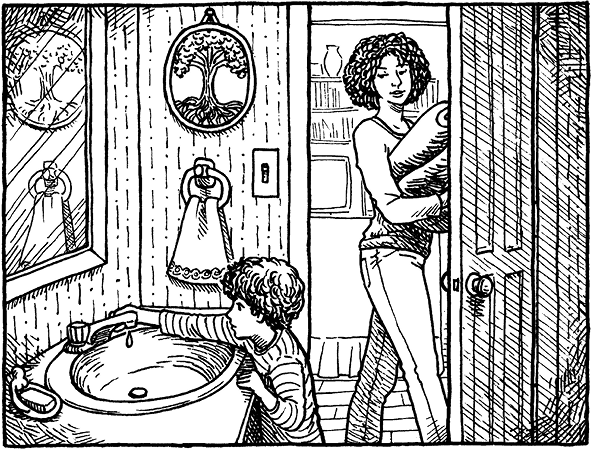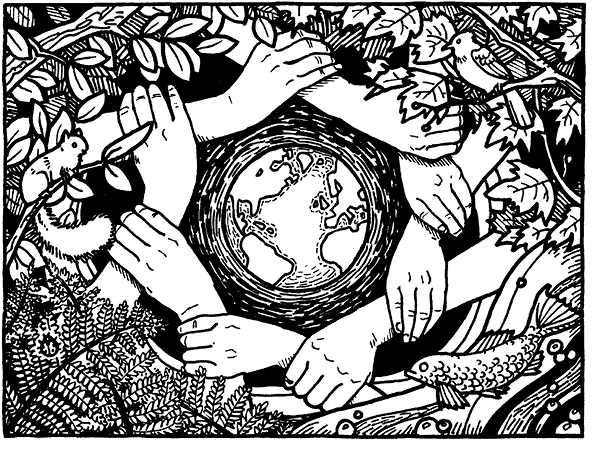From Care to Karma:
Inspiring Our Kids
to Care for Mother Earth
by Hannah E. Johnston
Pagans consider the world to be a beautiful, complex, animate entity. We try to spend as much time as possible attuning to her, giving and receiving energy, and attempting to restore the balance that mankind has skewed. As the human population surpasses seven billion, we strain the resources of beautiful Gaia. Despite her inexhaustible resilience, teaching our children about our reliance on Mother Earth is fundamental to our survival. By seeing all of nature’s creations as an intricate part of the whole and that together this great buzzing mass of the world is sacred, we have a responsibility to do our part to ensure its healing and its continuation.
Before taking care of the world, we must first learn how to care of ourselves. Our basic job as parents and as educators is to keep our kids alive until they can care for themselves. As such, when we do everything for them, we do them a disservice because we interfere with their capacity to self-care. Today so much is done for our kids that simple tasks can become a battleground—but taking the rubbish out, tidying the bedroom, and laying a table are important life skills to learn. Unless we value our kids and remain consistent in our approach, they will not see these basic tasks as a sign of self-care. To learn, children must be motivated and be allowed to approach a skill by their own volition and see how the task or skill fulfills a greater purpose. It is hard to teach a kid to clean when you hire a cleaner. When we ask children to undertake self-care and household work, we can reward them, acknowledging their meaningful contribution to family life.
Putting Ideas into Action
Rewarding positive behavior is great in theory, but it is always a bit more difficult when it comes down to brass tacks. Here are some pointers to get you and your family buzzing with care for themselves, for Mother Earth, and for all who dwell within her.

Our first step is to make it fun! Eco-guilt doesn’t work, especially with kids. Neither, necessarily, does turning recycling or conservation into an art project. At best, choose ways of being that are easily integrated into daily life. However you want to approach caring for the earth, make it part of life’s pattern of joy. “Conserve, conserve, conserve!” I heard this sung as a chant to an improvised ditty by a mum at playgroup as she taught her two-year-old to turn off the water after washing her hands. Simple yet so effective. Use this when switching off lights, turning off water, or saving food for the rabbit. Whatever it is, if you sing this mnemonic, you will quickly find your kids doing it. (Well, as long as they are under seven. If they are older than that, they will think you have finally gone crazy!) Pagans are so good at creating little snippets of doggerel rhyme. Make a few in your family that accompany little tasks that bring our wee ones’ attention to conserving energy.
Reduce, Reuse, Recycle: Respect
These three R’s are a literal interpretation of the means to tread gently. Reduce our consumption; reduce the unnecessary waste of energy. Reuse: can you use that old T-shirt as a duster? Can your rubbish become precious in another’s hands? In the natural world, everything has multiple functions and goes through stages so that even in death it brings nourishment, shelter, or use to another life form. Consider whether your rubbish can be transformed into something new. And if it cannot be reused, then recycle. We need to ensure that our kids know where waste goes by educating ourselves about our local waste networks or visiting a waste center. We should inform our kids that there are whole cities built on our waste because our waste gets sent to developing countries. When we weigh the energy costs of recycling commercially, it doesn’t always give us the warm feeling we hoped it would. If you show children the results of such waste disposal, unencumbered by the lackadaisical attitudes we adults have developed, they will cut to the heart of the matter, and, before you know it, will have organized their school and their friends to campaign for local recycling.
However, there are some simple ways to recycle. First, donate clothes, toys, and household objects. Compost everything—get worms! If worms aren’t your thing (though they are for so many Pagans since they are truly nature’s magic makers) co-opt other animal allies. Consider keeping scrap-eating animals—chickens, goats, and, of course, rabbits. Rabbits are wonderful when properly kept as pets and are allies in recycling. They eat a lot of your scraps, are good for cuddling, and require less space than a goat!
Be conscious of packaging. Try to buy goods that have little packaging or compostable packaging. It’s worth those extra pennies. Importantly, cook only what you need, and encourage kids to finish their food. Part of this for our family has been to bless every meal. By blessing meals, we help kids connect to and show respect for what they eat, which leads to being less inclined to waste it. In our home, we bless the food by acknowledging the communities that have brought it to our table; the elements of earth, air, fire, and water; and, most specifically, the animals, farmers, factory workers, packers, supermarket, and delivery people:
Blessings upon all who bring this food to our table (allow your kids to extemporise here), and blessings upon Mother Earth, who nourishes our bodies and souls with her gracious bounty.
Trust me, whether the blessing is long or short, younger and older kids waste less when they acknowledge what has gone into bringing a meal before them. (Boo, my little one, likes to thank the people who made the cutlery!)
Respect, a crucial Pagan ethic, becomes a natural extension of these approaches. These actions demonstrate our respect for the earth, for ourselves, for each other, and for the planet.
All things are connected. Teaching and modeling conservation—whether this is helping a four-year-old turn off a running tap whilst brushing his teeth, or allowing your teenager to hang out at the local park as long as she has an old plastic bag to clear some litter as she loiters—demonstrates the connection between our relationship with the world and our relationships with each other. It also builds self-respect. To conserve something means to keep, to protect, to work with. Conserving is dynamic. Conservation means working to protect something that is valued. Conservation is the perfect model of care, as it fosters an approach based on guardianship. Encourage your kids to be modern-day knights, healers, and witches. All these roles were created to help conserve the well-being of a place.
K Is for Karma
The three R’s are building blocks to understanding karma, or the law of eternal return. By karma, I refer to the ancient belief that as all things are connected through their relationship here on Earth, we meet all things with respect and consideration. In doing so, we hope that such respect will be reflected back to us and the balance of the world maintained. Many people misinterpret karma as a “tit for tat” understanding of the world, as if to say, “If I do something bad, something bad will happen to me.” Boo, my youngest at age five, saw the world entirely in these terms: “If Julian hits me, then I hit him back.” Essentially, what we attempt to foster in place of such clumsy justice is the law of consequences, which suggests that for every action there is a reaction. We have the capacity to choose that action and thus accept the consequences for ourselves and others. If we successfully do this, then we have established an ethical and moral framework for our children to test.

Karma is a map enabling us to see the consequences of our actions before they bear fruit. As such, karma is a means of understanding the future, as powerful and insightful as any tarot reading or crystal ball. For many Pagans, with our love of threes (and our backdoor adoration of old occultists!) when we discuss karma we refer to the law of threefold return—whatever you do comes back to you threefold. As adults, we understand that this is a safety measure to ensure that we fully consider both our magical and mundane actions. This is not to quash our ability to make decisions but to help us maintain an awareness of the world’s interconnectedness and perhaps to help us think about how our own actions may ripple beyond our immediate sphere.
I often think about this law when I think about our old family car, Silver Fin. I love beautiful things (I am a Taurean after all), but I also have a compulsion to give my belongings to people when they need them. I mentally catalogue our belongings, and when we get to what I consider overload, I give them away. I enjoy the feeling of lightness it brings me and the frisson it creates between my husband and I as he tries to guess what I will get rid of next!
With two growing boys, we gave their outgrown clothes to friends whose son was a wee bit smaller than ours. One of the most wonderful models of the threefold return came when we finally realized we needed a car and these same friends gifted their old car to us. A strong friendship and all those months of ensuring their son had our boys’ outgrown clothes were recognized in one extraordinary act of kindness and generosity. Such a model of threefold return may not always be your reality, but to show our kids that what you do comes back to you is an excellent way of inspiring them. Thus, recycling, conservation, and respecting take on deeper levels of meaning. Recycling becomes a spiritual act, conservation a duty of care, and an attitude of respect a modus operandi for relating to people, places, and all beings. And, as we cultivate these qualities, the Goddess smiles upon us.